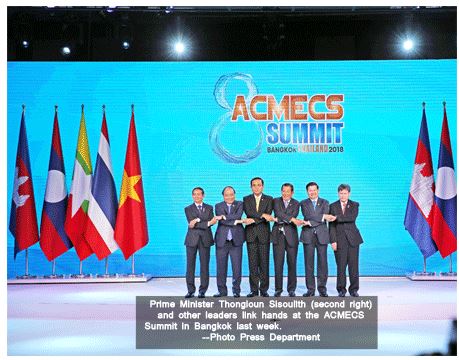Laos to host CLMV Summit in 2020
The next Cambodia, Laos, Myanmar, Vietnam (CLMV) Summit will be held in Vientiane in 2020 when Laos will chair the summit, while Cambodia will chair the 9th Ayeyawady-Chao Phraya-Mekong Economic Cooperation Strategy (ACMECS) Summit.
The host countries for the next summits were announced after the close of the 8th ACMECS and 9th CLMV summits held in Bangkok, Thailand, from June 15-16.
Prime Minister Thongloun Sisoulith, who led the Lao delegation attending these summits, gave an interview to Thai media on trade and investment cooperation between Laos and Thailand and the development of special economic zones in Laos.
Mr Thongloun held bilateral meetings with Vietnamese Prime Minister Nguyen Xuan Phuc and Thai Prime Minister Gen Prayut Chan-o-cha.
The Lao prime minister also had a breakfast meeting with Cambodian Prime Minister Hun Sen and Vietnamese Prime Minister Nguyen Xuan Phuc, with the aim of further strengthening bilateral cooperation and ties within the region.
The Bangkok Declaration from the 8th ACMECS Summit, which took the theme “Towards an Integrated and Connected Mekong Community”, said the leaders noted with satisfaction that since the establishment of ACMECS in 2003, the body had made important progress in promoting socio-economic development in the Mekong Sub-region, including in the implementation of the ACMECS Plan of Action 2016-2018. This demonstrated the shared commitment and spirit of long-lasting cooperation among the five countries to strengthen relations to promote peace, stability and sustainable and inclusive development in the sub-region based on good neighbourliness, friendship, mutual interest and understanding.
The leaders expressed their appreciation to the Kingdom of Thailand for proposing the concept of the ACMECS Master Plan, which sought to optimise the operational structure and utilise ACMECS’ economic potential to enhance its inclusion into the regional and global supply and value chain.
The specific goals, strategy and practical work plan outlined in the Master Plan reflect the current global and regional situation, priorities and needs of the ACMECS countries as well as addressing the challenges facing the sub-region and the world today.
The master plan, which focuses on multidimensional connectivity and highlights a people-centered approach, aims to complement the Master Plan on Asean Connectivity 2025, narrow the development gap, and contribute to the process of Asean community building and the achievement of the Sustainable Development Goals.
The summit welcomed the outcome of the three meetings of the Working Group on Drafting the ACMECS Master Plan hosted by the Kingdom of Thailand, which led to the successful, forward-looking ACMECS Master Plan for the next five years (2019-2023) under the vision of “Building ACMECS CONNECT by 2023.”
The leaders also adopted the ACMECS Master Plan in which ACMECS cooperation will be carried out through the three goals/pillars operating under each Pillar’s Coordinating Committee, namely Seamless ACMECS to promote seamless connectivity from multi-modal transports links including roads, rail, bridges, ports, air, inland waterways, and maritime connectivity, Synchronised ACMECS Smart to promote Fintech and cooperation between banks and other financial service providers, and Sustainable ACMECS to promote the development of human capital in strategic areas.
At the CLMV Summit, held under the theme “For Greater Economic Integration and Connectivity”, leaders recalled the CLMV progress in the past year and discussed how to further harness member countries’ economic potential and enhance cooperation in priority areas in order to achieve sustainable and inclusive development in the region and promote infrastructure and people-to-people linkages, thereby contributing to the development of the Asean community.
The leaders was also discussed eight priority sectors, including transport, trade and investment coordination, industry, tourism, human resource development, agriculture, energy, and ICT.
The four nations will work to build missing roads in their transport connectivity, upgrade sections in the North-South Economic Corridor, East-West Economic Corridor, and South Economic Corridor, accelerate construction of the Vientiane-Hanoi expressway, and study the feasibility of a road running through Myanmar, Laos and Vietnam.
Source: http://www.vientianetimes.org.la/FreeContent/FreeConten_Laos_139.php


 Thailand
Thailand




